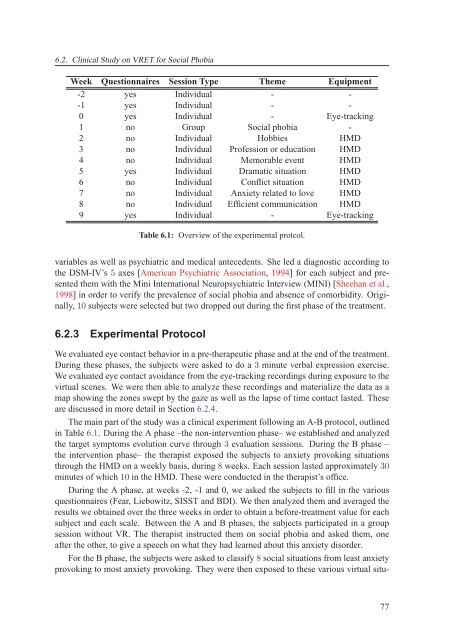Texte intégral / Full text (pdf, 20 MiB) - Infoscience - EPFL
Texte intégral / Full text (pdf, 20 MiB) - Infoscience - EPFL
Texte intégral / Full text (pdf, 20 MiB) - Infoscience - EPFL
Create successful ePaper yourself
Turn your PDF publications into a flip-book with our unique Google optimized e-Paper software.
6.2. Clinical Study on VRET for Social Phobia<br />
Week Questionnaires Session Type Theme Equipment<br />
-2 yes Individual - -<br />
-1 yes Individual - -<br />
0 yes Individual - Eye-tracking<br />
1 no Group Social phobia -<br />
2 no Individual Hobbies HMD<br />
3 no Individual Profession or education HMD<br />
4 no Individual Memorable event HMD<br />
5 yes Individual Dramatic situation HMD<br />
6 no Individual Conflict situation HMD<br />
7 no Individual Anxiety related to love HMD<br />
8 no Individual Efficient communication HMD<br />
9 yes Individual - Eye-tracking<br />
Table 6.1: Overview of the experimental protcol.<br />
variables as well as psychiatric and medical antecedents. She led a diagnostic according to<br />
the DSM-IV’s 5 axes [American Psychiatric Association, 1994] for each subject and presented<br />
them with the Mini International Neuropsychiatric Interview (MINI) [Sheehan et al.,<br />
1998] in order to verify the prevalence of social phobia and absence of comorbidity. Originally,<br />
10 subjects were selected but two dropped out during the first phase of the treatment.<br />
6.2.3 Experimental Protocol<br />
We evaluated eye contact behavior in a pre-therapeutic phase and at the end of the treatment.<br />
During these phases, the subjects were asked to do a 3 minute verbal expression exercise.<br />
We evaluated eye contact avoidance from the eye-tracking recordings during exposure to the<br />
virtual scenes. We were then able to analyze these recordings and materialize the data as a<br />
map showing the zones swept by the gaze as well as the lapse of time contact lasted. These<br />
are discussed in more detail in Section 6.2.4.<br />
The main part of the study was a clinical experiment following an A-B protocol, outlined<br />
in Table 6.1. During the A phase –the non-intervention phase– we established and analyzed<br />
the target symptoms evolution curve through 3 evaluation sessions. During the B phase –<br />
the intervention phase– the therapist exposed the subjects to anxiety provoking situations<br />
through the HMD on a weekly basis, during 8 weeks. Each session lasted approximately 30<br />
minutes of which 10 in the HMD. These were conducted in the therapist’s office.<br />
During the A phase, at weeks -2, -1 and 0, we asked the subjects to fill in the various<br />
questionnaires (Fear, Liebowitz, SISST and BDI). We then analyzed them and averaged the<br />
results we obtained over the three weeks in order to obtain a before-treatment value for each<br />
subject and each scale. Between the A and B phases, the subjects participated in a group<br />
session without VR. The therapist instructed them on social phobia and asked them, one<br />
after the other, to give a speech on what they had learned about this anxiety disorder.<br />
For the B phase, the subjects were asked to classify 8 social situations from least anxiety<br />
provoking to most anxiety provoking. They were then exposed to these various virtual situ-<br />
77

















